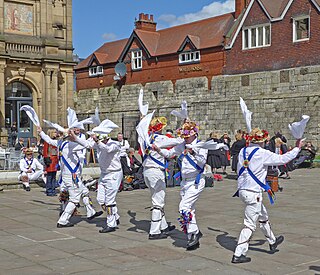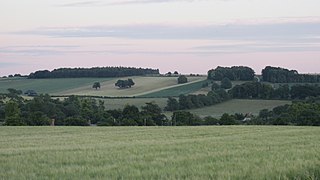Related Research Articles

Morris dancing is a form of English folk dance. It is based on rhythmic stepping and the execution of choreographed figures by a group of dancers, usually wearing bell pads on their shins. Implements such as sticks, swords and handkerchiefs may also be wielded by the dancers. In a small number of dances for one or two people, steps are near and across a pair of clay tobacco pipes laid one across the other on the floor. They clap their sticks, swords, or handkerchiefs together to match with the dance.

Wallingford is a historic market town and civil parish located between Oxford and Reading on the River Thames in England. Although belonging to the historic county of Berkshire, it is within the ceremonial county of Oxfordshire for administrative purposes as a result of the 1972 Local Government Act. Wallingford is 12 miles (19 km) north of Reading, 13 miles (21 km) south of Oxford and 11 miles (18 km) north west of Henley-on-Thames. The town's population was 11,600 in the 2011 census.

Abingdon-on-Thames, commonly known as Abingdon, is a historic market town and civil parish in the ceremonial county of Oxfordshire, England, on the River Thames. Historically the county town of Berkshire, Abingdon has been administered since 1974 by the Vale of White Horse district within Oxfordshire. The area was occupied from the early to middle Iron Age and the remains of a late Iron Age and Roman defensive enclosure lies below the town centre. Abingdon Abbey was founded around 676, giving its name to the emerging town. In the 13th and 14th centuries, Abingdon was an agricultural centre with an extensive trade in wool, alongside weaving and the manufacture of clothing. Charters for the holding of markets and fairs were granted by various monarchs, from Edward I to George II.

The Vale of White Horse is a local government district of Oxfordshire in England. It was historically a north-west projection of Berkshire. The area is commonly referred to as the 'Vale of the White Horse'. It is crossed by the Ridgeway National Trail in its far south, across the North Wessex Downs AONB at the junction of four counties. The northern boundary is defined by the River Thames. The name refers to Uffington White Horse, a prehistoric hill figure.

South Oxfordshire is a local government district in the ceremonial county of Oxfordshire, England. Its council is temporarily based outside the district at Abingdon-on-Thames pending a planned move to Didcot, the district's largest town. The areas located south of the River Thames are within the historic county of Berkshire.

Tenterden is a town in the borough of Ashford in Kent, England. It stands on the edge of the remnant forest the Weald, overlooking the valley of the River Rother. It was a member of the Cinque Ports Confederation. Its riverside today is not navigable to large vessels and its status as a wool manufacturing centre has been lost. Tenterden has several voluntary organisations, some of which are listed below, a large conservation area and seven large or very old public houses within its area. It has long distance walking and cycling routes within its boundaries.

Thaxted is a town and civil parish in the Uttlesford district of north-west Essex, England. The town is in the valley of the River Chelmer, not far from its source in the nearby village of Debden, and is 97 metres above sea level. The town is 15 miles (24 km) north from the county town of Chelmsford, and 5.5 miles (9 km) east from the M11 motorway. The parish contains the hamlets of Cutlers Green, Bardfield End Green, Sibleys Green, Monk Street, and Richmond's Green. Much of its status as a "town" rests on its prominent late medieval guildhall, a place where guilds of skilled tradesmen regulated their trading practices, and its English Perpendicular parish church.

Builth Wells is a market town and community in the county of Powys and historic county of Brecknockshire (Breconshire), mid Wales, lying at the confluence of rivers Wye and Irfon, in the Welsh part of the Wye Valley. In 2011 it had a population of 2,568.

Oxford West and Abingdon is a constituency represented in the House of Commons of the UK Parliament since 2017 by Layla Moran, a Liberal Democrat.

Up Helly Aa is a type of fire festival held annually from January to March in various communities in Shetland, Scotland, to mark the end of the Yule season. Each festival involves a torchlit procession by squads of costumed participants that culminates in the burning of an imitation Viking galley. The largest festival held in Lerwick, Shetland's capital, involves a procession of up to a thousand guizers who march through the streets of Lerwick on the last Tuesday in January. The other rural festivals see lower numbers of participants in accordance with their lower populations.

Oxford City Council is the lower-tier local government authority for the city of Oxford in England, providing such services as leisure centres and parking. Social Services, Education and Highways services are provided by Oxfordshire County Council.

Morland was an English brewery founded in Abingdon-on-Thames, Oxfordshire, and was brewing beer industrially by 1711. It was the second oldest brewer in England up until it was bought by Greene King in 2000. Morland's beers include Hen's Tooth, Old Speckled Hen, Tanner's Jack and Morland's Original.

Narberth is a town and community in Pembrokeshire, Wales. It was founded around a Welsh court and later became a Norman stronghold on the Landsker Line. It became the headquarters of the hundred of Narberth. It was once a marcher borough. George Owen described it in 1603 as one of nine Pembrokeshire "boroughs in decay".

The election of a mock mayor is British folk tradition found in a number of communities throughout the British Isles. A mock mayor is an individual who is elected by a popular informal assembly of individuals as a parody of the official office of mayor in any given community.

Abingdon Park is a park on Park Road in the northwest of the town of Abingdon, Oxfordshire, England.

The Abingdon Sword is a late Anglo-Saxon iron sword and hilt believed to be from the late 9th or early 10th century; only the first few inches of the blade remain attached to the hilt.

Mansfield is a market town and the administrative centre of the Mansfield District in Nottinghamshire, England. It is the largest town in the wider Mansfield Urban Area. It gained the Royal Charter of a market town in 1227. The town lies in the Maun Valley, 12 miles (19 km) north of Nottingham. It had a population of 110,500 at the 2021 census, according to the Office for National Statistics. Mansfield is the one local authority in Nottinghamshire with a publicly elected mayor.
George Knapp was a British Member of Parliament.
Arthur Edwin Preston (1852-1942) was the Mayor of Abingdon-on-Thames, Master of Christ's Hospital and an antiquarian and historian.

A bun throwing is held in Abingdon-on-Thames, England, to mark special and royal occasions. During the event thousands of currant buns are thrown from the roof of the County Hall by members of the Abingdon Town Council. The council states that the event has a 400-year history, though the first known throwing took place in 1760 or 1761 to mark the accession or coronation of George III and Charlotte. The buns are sometimes marked with insignia related to the event being commemorated and are often kept as mementoes.
References
- 1 2 "The Horns | Abingdon Traditional Morris Dancers". Archived from the original on 19 April 2022. Retrieved 7 May 2023.
- 1 2 "Election of the Mayor of Ock Street – Abingdon on Thames Town Council". Archived from the original on 4 January 2023. Retrieved 7 May 2023.
- ↑ Argyle, Leslie (2006). Cameos of Abingdon. Abingdon Town Council. p. 50.
- 1 2 "An old Abingdon tradition means two mayors are elected not one". Oxford Mail. Archived from the original on 4 July 2021. Retrieved 7 May 2023.
- ↑ "Mayor of Ock Street". Oxford Reference.
- ↑ Smith, Jacqueline; Carter, John (1989). Inns and Alehouses of Abingdon 1550–1978. p. 70.